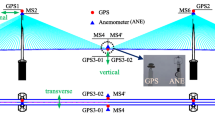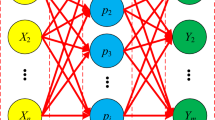Abstract
Various sensors have been installed in cable-stayed bridges to monitor the behavior of structures and external conditions. These sensors alert the administrator to take appropriate action when an abnormal signal is detected. Although inherent meaningful information about the history of structural responses in long-term accumulated measurement data are available, the methodology for utilizing such data in the long-term point of view has not yet been established. Structural response is determined by the mechanical principle of external loads and the structural system characteristics. Assuming that structural responses have a certain pattern in a constant condition, the state of the structure can be estimated to have changed or not through an analysis of the pattern variation of the measured data. This study utilizes the temperature and displacement data of a cable-stayed bridge to analyze the pattern variation of the measurement data. An autoregressive model is used to define the pattern of the time series data. A pattern model is then constructed with the data adopted as a reference for comparison. The compared data are applied to the pattern model to simulate the data reflecting the reference data pattern. Subsequently, the simulated data are compared with the actual data, and the pattern difference is computed through the error discriminant index.









Similar content being viewed by others
References
Abdeljaber, O., & Avci, O. (2016). Nonparametric structural damage detection algorithm for ambient vibration response: utilizing artificial neural networks and self-organizing maps. Journal of Architectural Engineering, 22(2), 04016004.
Abdeljaber, O., Avci, O., Kiranyaz, S., Gabbouj, M., & Inman, D. J. (2017). Real-time vibration-based structural damage detection using one-dimensional convolutional neural networks. Journal of Sound and Vibration, 388, 154–170.
Cho, H. N., Kang, K. K., & Cha, C. J. (2005). Reliability-based managing criteria for cable tension force in cable-stayed bridges. Journal of the Korea institute for Structural Maintenance and Inspection, 9(3), 129–138.
Choi, J., Lee, K., & Kang, Y. (2017). Quasi-static responses estimation of a cable-stayed bridge from displacement data at a limited number of points. International Journal of Steel Structures, 17(2), 789–800.
Chung, C. H., An, H. H., Shin, S. B., & Kim, Y. H. (2014). Reset of measurement control criteria for monitoring data through the analysis of measured data. Journal of the Korea Institute for Structural Maintenance and Inspection, 18(6), 105–113.
Cross, E. J., Koo, K. Y., Brownjohn, J. M. W., & Worden, K. (2013). Long-term monitoring and data analysis of the Tamar Bridge. Mechanical Systems and Signal Processing, 35(1–2), 16–34.
Datteo, A., Lucà, F., & Busca, G. (2017). Statistical pattern recognition approach for long-time monitoring of the G. Meazza stadium by means of AR models and PCA. Engineering Structures, 153, 317–333.
Figueiredo, E., Todd, M. D., Farrar, C. R., & Flynn, E. (2010). Autoregressive modeling with state-space embedding vectors for damage detection under operational variability. International Journal of Engineering Science, 48(10), 822–834.
Guidorzi, R., Diversi, R., Vincenzi, L., Mazzotti, C., & Simioli, V. (2014). Structural monitoring of a tower by means of MEMS-based sensing and enhanced autoregressive models. European Journal of Control, 20(1), 4–13.
Hearn, G., & Testa, R. B. (1991). Modal analysis for damage detection in structures. Journal of Structural Engineering, 117(10), 3042–3063.
Islam, M. S., & Bagchi, A. (2014). Statistical pattern-based assessment of structural health monitoring data. Mathematical Problems in Engineering, 2014, 926079.
Kaloop, M. R., Hussan, M., & Kim, D. (2019). Time-series analysis of GPS measurements for long-span bridge movements using wavelet and model prediction techniques. Advances in Space Research, 63(11), 3505–3521.
Kim, H. J. (2017). Analysis of variation rate of displacement to temperature of service stage cable-stayed bridge using temperatures and displacement data. In Dynamics of Civil Structures, Volume 2 (pp. 21–25). Springer, Cham.
Kim, H. B., & Song, J. H. (2016). Study for determination of management thresholds of bridge structural health monitoring system based on probabilistic method. Journal of the Korea Institute for Structural Maintenance and Inspection, 20(3), 103–110.
Langone, R., Reynders, E., Mehrkanoon, S., & Suykens, J. A. (2017). Automated structural health monitoring based on adaptive kernel spectral clustering. Mechanical Systems and Signal Processing, 90, 64–78.
Lin, Y. Z., Nie, Z. H., & Ma, H. W. (2017). Structural damage detection with automatic feature-extraction through deep learning. Computer-Aided Civil and Infrastructure Engineering, 32(12), 1025–1046.
Padil, K. H., Bakhary, N., & Hao, H. (2017). The use of a non-probabilistic artificial neural network to consider uncertainties in vibration-based-damage detection. Mechanical Systems and Signal Processing, 83, 194–209.
Sohn, H., Farrar, C. R., Hunter, N. F., & Worden, K. (2001). Structural health monitoring using statistical pattern recognition techniques. Journal of Dynamic Systems, Measurement, and Control, 123(4), 706–711.
Teng, S., Chen, G., Gong, P., Liu, G., & Cui, F. (2019). Structural damage detection using convolutional neural networks combining strain energy and dynamic response. Meccanica, 55, 945–959.
Wang, L., Wang, X., Su, H., & Lin, G. (2017). Reliability estimation of fatigue crack growth prediction via limited measured data. International Journal of Mechanical Sciences, 121, 44–57.
Xia, Q., Cheng, Y., Zhang, J., & Zhu, F. (2017). In-service condition assessment of a long-span suspension bridge using temperature-induced strain data. Journal of Bridge Engineering, 22(3), 04016124.
Yao, R., & Pakzad, S. N. (2012). Autoregressive statistical pattern recognition algorithms for damage detection in civil structures. Mechanical Systems and Signal Processing, 31, 355–368.
Ye, C., Butler, L. J., Elshafie, M. Z., & Middleton, C. R. (2020). Evaluating prestress losses in a prestressed concrete girder railway bridge using distributed and discrete fibre optic sensors. Construction and Building Materials, 247, 118518.
Yule, G. U. (1927). VII. On a method of investigating periodicities disturbed series, with special reference to Wolfer’s sunspot numbers. Philosophical Transactions of the Royal Society of London. Series A, Containing Papers of a Mathematical or Physical Character, 226(636–646), 267–298.
Zhou, G. P., Li, A. Q., Li, J. H., & Duan, M. J. (2018). Health monitoring and comparative analysis of time-dependent effect using different prediction models for self-anchored suspension bridge with extra-wide concrete girder. Journal of Central South University, 25(9), 2025–2039.
Acknowledgements
This work was supported by the National Research Foundation of Korea (NRF) grant funded by the Korea Government (MIST). (No. 2020R1A2C201445011).
Author information
Authors and Affiliations
Corresponding author
Additional information
Publisher's Note
Springer Nature remains neutral with regard to jurisdictional claims in published maps and institutional affiliations.
Rights and permissions
About this article
Cite this article
Lee, Y., Jang, M., Kim, S. et al. A Study on the Long-Term Measurement Data Analysis of Existing Cable Stayed Bridge Using ARX Model. Int J Steel Struct 20, 1871–1881 (2020). https://doi.org/10.1007/s13296-020-00376-8
Received:
Accepted:
Published:
Issue Date:
DOI: https://doi.org/10.1007/s13296-020-00376-8




